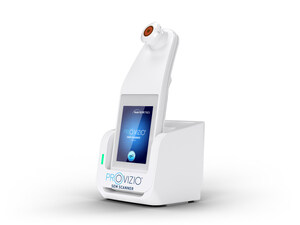Study: SEM Scanner Detects Bedsores Before Visual Diagnosis
BBI's Device Takes Aim at £2.1bn Public Health Problem
MANCHESTER, England and LOS ANGELES, June 20, 2017 /PRNewswire/ -- A wireless handheld scanner detected bedsores developing under the skin earlier than visual inspection of the surface of the skin. This gives clinicians an alert that enables them to intervene early and reverse damage before the sores break through the skin and turn potentially deadly, researchers have found.
The study involved 182 patients at risk for bedsores at 12 hospitals, nursing home and long-term rehabilitation centers in the United States and the United Kingdom -- the first large-scale study of the scanner to be conducted simultaneously in both countries, according to Bruin Biometrics ("BBI, LLC"), which developed the device, known as the SEM Scanner.
SEM Scanner received CE Mark approval and is currently available in the United Kingdom, Ireland and Canada. BBI included the study findings in a filing to the U.S. Food And Drug Administration for approval to market the device in the U.S.
Bedsores (or "pressure ulcers") can lead to pain, disfigurement, infection and deadly complications that kill more people annually than any form of cancer except lung cancer at a total annual cost of £2.1bn to the National Health Service. The sores result from pressure involving shear and/or friction causing localized damage to the skin and underlying tissue, usually around areas of bony prominence -- such as the vertebra, tailbone, heels, and hips.
In the new study, investigators conducting daily visual skin assessments and scans for up to twenty days found that the SEM Scanner detects pressure damage to skin earlier than visual skin evaluation by nurses. Investigators are presenting their topline results today at the scientific session of Wound Care: From Innovations to Clinical Trials 2017, a medical conference in Manchester, U.K.
"Nurses can get a head-start on prevention with the early warning from the scanner," said Jeanette Milne, clinical lead for tissue viability at Northumbria Healthcare NHS Foundation Trust. "Scanner data provides objective information that not only identifies patients with incipient damage, but also those who are at risk but with no visible signs of tissue damage. This will enable clinicians to provide bespoke care rather than to prescribe generic interventions based just on risk assessment and clinical judgement, which can be inaccurate and labour-intensive."
Henry Okonkwo, a study investigator providing skilled wound care to nursing homes and acute care facilities in the United States, said: "The study results indicate that the SEM Scanner can detect changes before they are visible. Objective, scientific data from the scanner would give me confidence to take action in my clinical practice."
BBI's vice president of product, Rachael Lester, said: "With these new findings, we expect that early detection technology will move to the forefront of bedsore prevention. The holy grail in prevention has been the search for a biophysical indicator that could reliably signal the presence of a condition at an early enough stage to meaningfully alter a patient's prognosis. Our SEM Scanner technology uses sub-epidermal moisture, or SEM, to monitor changes occurring at the cellular level where there is pressure damage."
The new research builds on earlier evidence from 1,200 patients participating in a BBI-sponsored program incorporating SEM Scanner into existing hospital bedsore prevention protocols. Seven hospitals in the U.K. and Canada eliminated bedsores and two achieved reductions of nearly 90 percent as a result of the program.
Findings from the program, presented last November at the Wounds UK annual conference, include research from Virgin Care and from St. Mary's Hospital on Isle of Wight that represent real-world evidence of SEM Scanner's effectiveness and upend the prevailing view that pressure ulcers cannot be diagnosed and treated until there is visible and irreversible damage at the skin's surface.
"We hope that today is a turning point in the war on pressure ulcers," BBI CEO Martin Burns declared. "We aim to massively decrease unnecessary patient injury and cost through a simple bedside scan that can detect developing wounds when they are at a preventable stage."
About Bedsores
Bedsores (or "pressure ulcers") can lead to pain, disfigurement, infection and deadly complications that kill more people annually than any form of cancer except lung cancer. The National Health Service spends £2.1bn – four percent of its annual budget – on bedsore treatment and prevention. The sores result from pressure involving shear and/or friction causing localized damage to the skin and underlying tissue, usually around areas of bony prominence -- such as the vertebra, tailbone, heels, and hips.
Across Europe and the United States, an estimated 18 to 25 percent of patients in both acute care and long-term care settings suffer from pressure ulcers, which disproportionately impact the elderly and patients with limited mobility. There are some 2.5 million pressure ulcer cases annually in the European Union, and nearly 500,000 in the United Kingdom.
Some 2.5 million Americans develop pressure ulcers annually in acute care facilities, and 60,000 Americans die annually from pressure ulcer complications such as cancer, sepsis, cellulitis, and MRSA.
About BBI
Bruin Biometrics ("BBI LLC"), a pioneer in biometric-sensor based medical devices, develops point-of-care diagnostic solutions for early detection and monitoring of chronic, preventable conditions. The company's first product is the SEM Scanner, a hand-held non-invasive device that assesses sub-epidermal moisture, a biomarker for pressure ulceration. Pressure ulcers affect approximately 25 percent of acute care hospital and long-term care patients – typically the elderly and immobile. SEM Scanner is CE Mark approved and is currently in full commercial launch in the United Kingdom, Ireland and Canada. SEM Scanner is pending approval from FDA, and is not available for sale in the United States.
BBI is also developing OrthoSonos, a non-invasive device for real-time orthopedic joint monitoring and assessment of prosthetic implant failure; and P02M, the first device for monitoring tissue oxygenation at a specific location in real time. P02M is initially being tested for continual monitoring of tissue and vascular viability in the feet of diabetics. Diabetes can cause peripheral artery disease and peripheral neuropathy, putting patients at risk for foot ulcers.
BBI is based in Los Angeles and maintains a European office in Manchester, UK.
For additional information, visit www.bruinbiometrics.com. Follow BBI on Twitter at https://twitter.com/bruinbiometrics.






Share this article